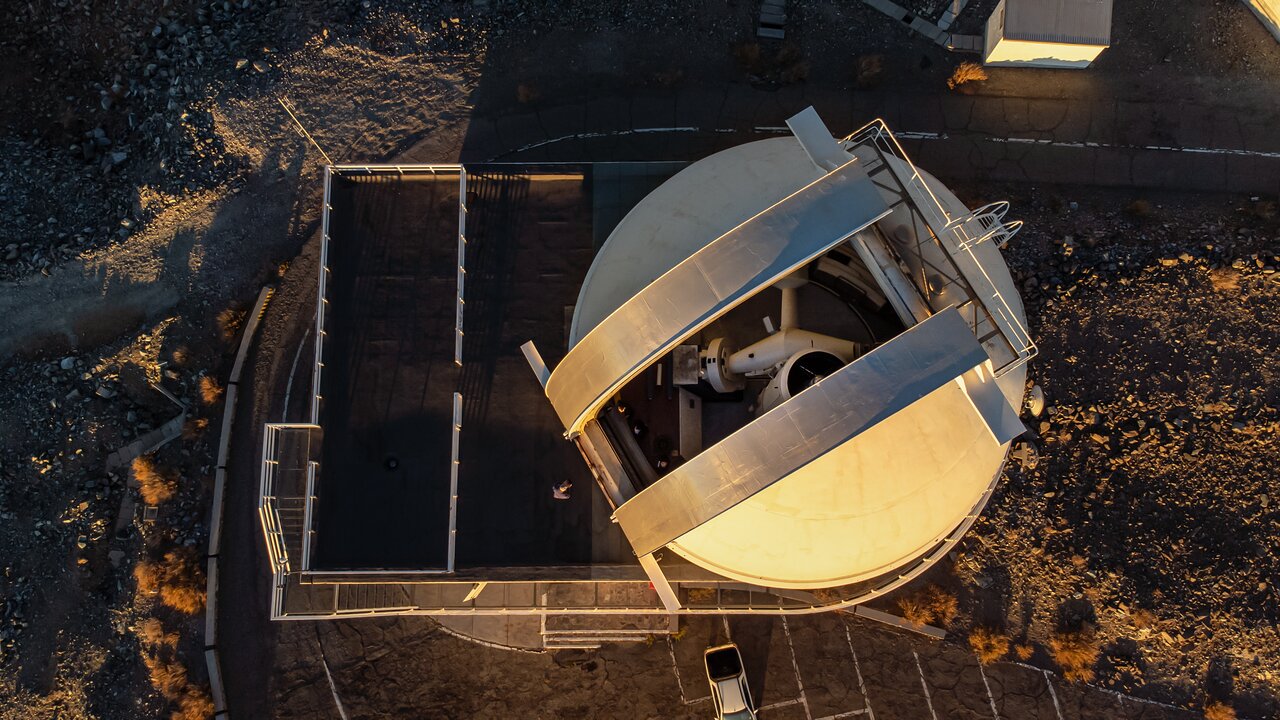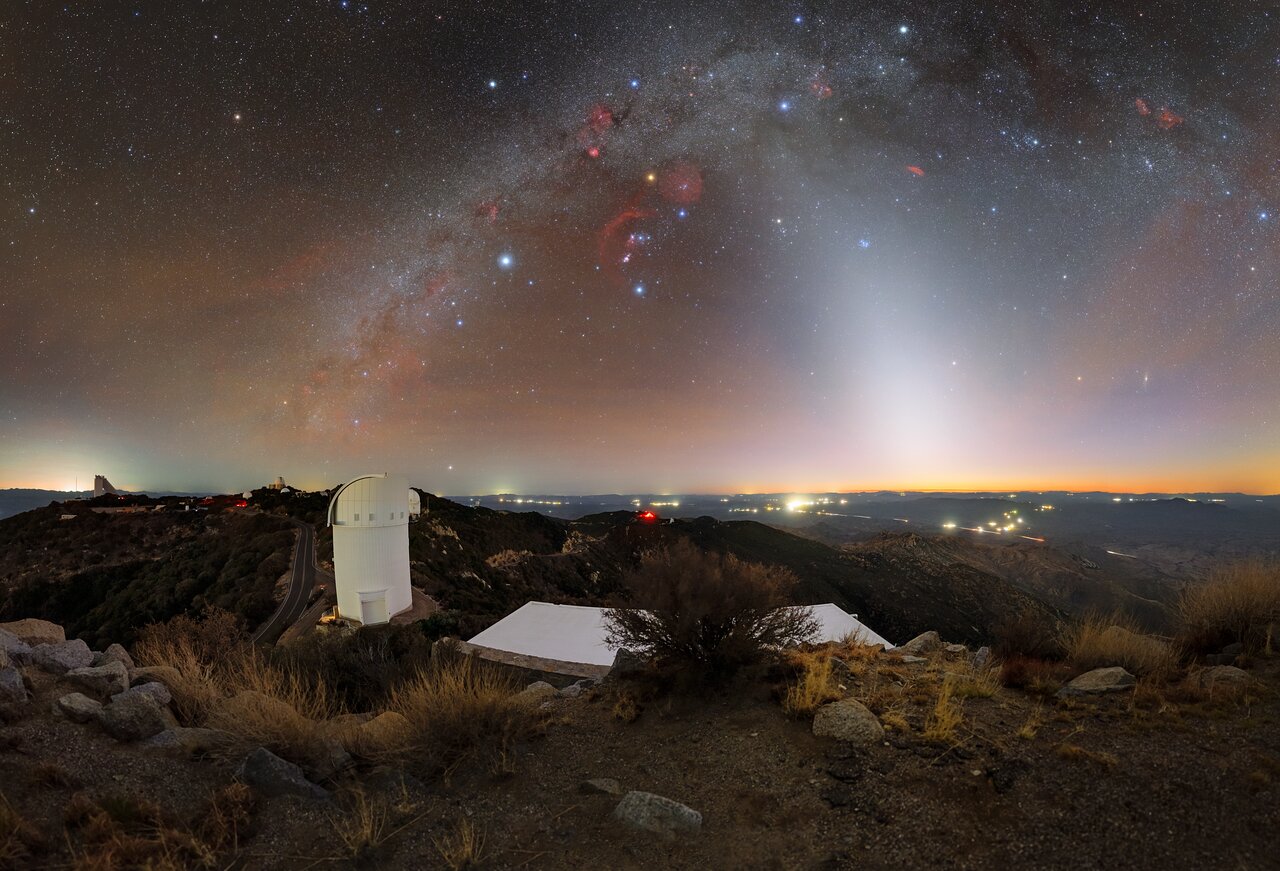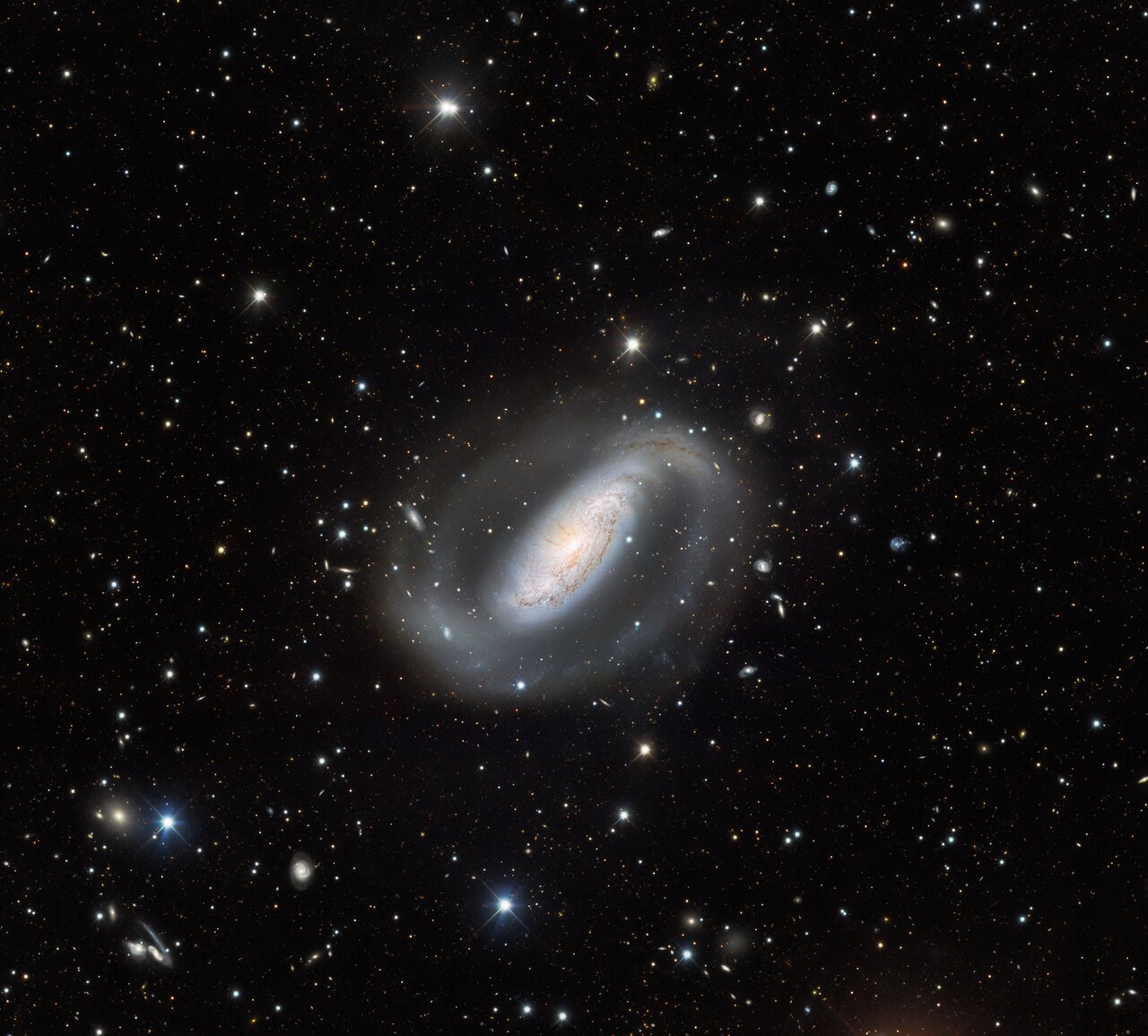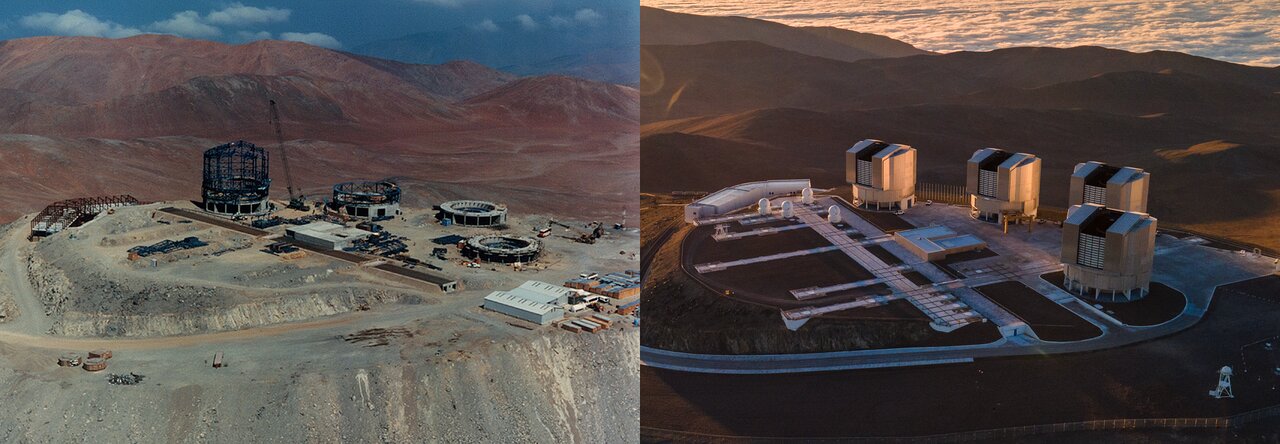Page 1 of 2
Found Images: 2023 May
Posted: Mon May 01, 2023 5:38 pm
by bystander
Have you seen a great image or video somewhere that you think would make a great APOD? Nominate it for APOD! Please post as much information here as you have about the image/video with a link to any source(s) for it you know of here, and the editors will take a look.
When posting the image itself, please do not post anything larger than a thumbnail here; please honor the copyright holder's copyright.
Please keep hotlinked images under 500K.
Thank you!
<< Previously
ESO: A Scarlet Cosmic Sea (Gum 10)
Posted: Mon May 01, 2023 8:00 pm
by bystander
A Scarlet Cosmic Sea
ESO Picture of the Week | 2023 May 01
In this colorful Picture of the Week we see a portion of the
Gum 10 nebula through the eyes of ESO’s
Very Large Telescope in Chile. Gum 10 was discovered by the Australian astronomer
Colin Stanley Gum, who in 1955 published a catalogue with more than 80 similar diffuse nebulae.
The energetic ultraviolet radiation from the hot blue stars in Gum 10
ionise the gas in the nebula, stripping electrons away from their atoms. When these electrons combine again with the atoms, they emit light at very specific colours or wavelengths. The
red shade in this image comes from hydrogen, the most abundant element in the Universe. The
dark areas are dense clouds of dust that partially block our view of the objects behind them.
This image, taken with the
FORS2 instrument, was created as part of the ESO
Cosmic Gems programme, an outreach initiative to produce images of interesting, intriguing or visually attractive objects using ESO telescopes, for the purposes of education and public outreach. The programme makes use of telescope time that cannot be used for science observations. All data collected may also be suitable for scientific purposes, and are made available to astronomers through ESO’s science archive.
ESA: Ghostly Galactic Jellyfish (JO175)
Posted: Mon May 01, 2023 8:09 pm
by bystander
Ghostly Galactic Jellyfish
ESA Hubble Picture of the Week | 2023 May 01
Credit: ESA/Hubble & NASA, M. Gullieuszik and the GASP team
The jellyfish galaxy JO175 appears to hang suspended in this image from the NASA/ESA Hubble Space Telescope. This galaxy lies over 650 million light-years from Earth in the appropriately-named constellation Telescopium, and was captured in crystal-clear detail by Hubble’s
Wide Field Camera 3. A handful of more distant galaxies are lurking throughout the scene, and a bright four-pointed star lies to the lower right side.
Jellyfish galaxies get their unusual name from the tendrils of star-forming gas and dust that trail behind them, just like the tentacles of a jellyfish. These bright tendrils contain clumps of star formation and give jellyfish galaxies a particularly striking appearance. Unlike their ocean-dwelling namesakes, jellyfish galaxies make their homes in galaxy clusters, and the pressure of the tenuous superheated plasma that permeates these galaxy clusters is what draws out the jellyfish galaxies’ distinctive tendrils.
Hubble recently completed a deep dive into jellyfish clusters, specifically the star-forming clumps of gas and dust that stud their tendrils. By studying the origins and fate of the stars in these clumps, astronomers hoped to better understand the processes underpinning star formation elsewhere in the Universe. Interestingly, their research suggests that star formation in the discs of galaxies is similar to star formation in the extreme conditions found in the tendrils of jellyfish galaxies.
Re: Found Images: 2023 May
Posted: Tue May 02, 2023 9:22 pm
by starsurfer
Re: Found Images: 2023 May
Posted: Tue May 02, 2023 9:27 pm
by starsurfer
Re: Found Images: 2023 May
Posted: Thu May 04, 2023 10:05 pm
by starsurfer
NGC 253
https://www.astrobin.com/311244/B/
Copyright: Tommy Nawratil
Re: Found Images: 2023 May
Posted: Thu May 04, 2023 10:07 pm
by starsurfer
Helix Nebula (NGC 7293)
https://www.astrobin.com/311097/C/
Copyright: Vadim Kozatchenko/Chilescope
Re: Found Images: 2023 May
Posted: Thu May 04, 2023 10:10 pm
by starsurfer
Pencil Nebula (NGC 2736)
https://www.flickr.com/photos/ytoropin/33117765403/
Copyright: Yuriy Toropin/Chilescope
Re: Found Images: 2023 May
Posted: Sun May 07, 2023 9:38 pm
by starsurfer
NGC 1398
https://www.chart32.de/index.php/component/k2/item/142
Copyright: CHART32
Processing: Johannes Schedler
Re: Found Images: 2023 May
Posted: Sun May 07, 2023 9:42 pm
by starsurfer
ESO: Peekaboo (1.52-m at LaSilla)
Posted: Mon May 08, 2023 1:49 pm
by bystander
Peekaboo
ESO Picture of the Week | 2023 May 08
The telescope peeking out from its dome is the
1.52-metre telescope at
La Silla Observatory. Being over 55 years old, the 1.52-metre is one of the oldest telescopes at ESO and it has participated in laying the foundation for many areas of astronomical research.
Being a special telescope in many ways, it also has a twin, the 1.52-metre telescope at the
Observatoire de Haute Provence in France. Both telescopes were specifically designed to do stellar
spectroscopy and astrophotography, and the 1.52-m in La Silla involved no less than five instruments, including the
B&C spectrograph. This instrument captured the
spectrum of the Hale-Bopp comet as it passed by in 1995, one of the first recorded spectrums of a comet.
After over 30 years of service, the 1.52-m at La Silla was decommissioned in 2002. Still sitting in its dome, it peers out over the vast Atacama Desert, and we get to marvel about all the things it has seen in the night sky.
ESA: Cosmic Leviathan
Posted: Mon May 08, 2023 2:10 pm
by bystander
Cosmic Leviathan
ESA Hubble Picture of the Week | 2023 May 08
A vast
galaxy cluster lurks in the centre of this image from the NASA/ESA Hubble Space Telescope. Like a submerged sea monster causing waves on the surface, this cosmic leviathan can be identified by the distortions in spacetime around it. The mass of the cluster has caused the images of background galaxies to be
gravitationally lensed; the galaxy cluster has caused a sufficient curvature of spacetime to bend the path of light and cause background galaxies to appear distorted into streaks and arcs of light. A host of other galaxies can be seen surrounding the cluster, and a handful of foreground stars with tell-tale diffraction spikes are scattered throughout the image.
This particular galaxy cluster is called eMACS J1823.1+7822, and lies almost nine billion light-years away in the constellation
Draco. It is one of five exceptionally massive galaxy clusters explored by Hubble in the hopes of measuring the strengths of these gravitational lenses and providing insights into the distribution of
dark matter in galaxy clusters. Strong gravitational lenses like eMACS J1823.1+7822 can help astronomers study distant galaxies by acting as vast natural telescopes which magnify objects that would otherwise be too faint or distant to resolve.
This multiwavelength image layers data from eight different filters and two different instruments: Hubble’s Advanced Camera for Surveys (
ACS) and Wide Field Camera 3 (
WFC3). Both instruments have the ability to view astronomical objects in just a small slice of the
electromagnetic spectrum using filters, which allow astronomers to image objects at precisely selected wavelengths. The combination of observations at different wavelengths lets astronomers develop a more complete picture of the structure, composition and behaviour of an object than visible light alone would reveal.
Re: Found Images: 2023 May
Posted: Mon May 08, 2023 9:19 pm
by starsurfer
Sh2-123
https://www.astrobin.com/lyukvj/
Copyright: James Peirce
Re: Found Images: 2023 May
Posted: Mon May 08, 2023 9:22 pm
by starsurfer
Re: Found Images: 2023 May
Posted: Mon May 08, 2023 9:24 pm
by starsurfer
Re: Found Images: 2023 May
Posted: Mon May 08, 2023 9:27 pm
by starsurfer
Cat's Eye Nebula (NGC 6543)
https://www.astrobin.com/306972/C/
Copyright: Jonas Illner
Re: Found Images: 2023 May
Posted: Mon May 08, 2023 9:29 pm
by starsurfer
Re: Found Images: 2023 May
Posted: Mon May 08, 2023 10:11 pm
by barretosmed
MOON
MORE DETAILS
https://www.astrobin.com/full/awwv9y/0/
EQUIPMENT:
ZWO ASI 6200MC COLED
Esprit 150mm
Baader Lunar Filter
Date: 05/01/2023
Location: Munhoz - MG - Brazil
PROCESSING AND CAPTURE: Software: Adobe Photoshop, SharpCap, AutoStakkert AutoStackert and Registax 6.
Copyright: Fernando Oliveira de Menezes
Email:
Barretosmed@hotmail.com
(Organizing author of the book Astrofotografia Amadora no Brasil)
https://clubedeautores.com.br/livro/ast ... -no-brasil
NOIRLab: Stellar Red Giant above KPNO
Posted: Thu May 11, 2023 2:01 am
by bystander
Stellar Red Giant above KPNO
NOIRLab Image of the Week | 2023 May 10
The dynamic coloring of the night sky at Kitt Peak National Observatory (
KPNO), a Program of NSF’s NOIRLab, makes for a beautiful backdrop behind the UArizona
Bok 2.3-meter Telescope. Distant city lights, cars,
airglow, and the arc of the Milky Way all add to the variety of colors.
Zodiacal light emanating from the horizon intersects with the Milky Way on the right hand side of the image.
One orange star at the center of this image stands out amongst the rest. This is the red supergiant
Betelgeuse, a star that marks a ‘shoulder’ of the hunter constellation,
Orion. Being a relatively old star,
Betelgeuse glows a cool red compared to its hot, bright blue neighbors. Despite this, it is usually the 10th brightest star in the night sky. More compellingly, Betelgeuse is massive — so massive that its diameter is more than 750 times that as the Sun. This makes it the largest star visible to the naked eye. Betelgeuse received some press in 2019 when a small explosion on its surface was observed, leading to speculation that a supernova was imminent. However, in 2021 scientists determined that the dying star won’t be exploding for at least another 100,000 years.
Re: Found Images: 2023 May
Posted: Sun May 14, 2023 9:46 pm
by starsurfer
UGC 2369
https://esahubble.org/images/potw1931a/
Copyright: ESA/Hubble & NASA, A. Evans
Re: Found Images: 2023 May
Posted: Sun May 14, 2023 9:48 pm
by starsurfer
ESO: A Fiery Sky over Paranal
Posted: Mon May 15, 2023 3:36 pm
by bystander
A Fiery Sky over Paranal
ESO Picture of the Week | 2023 May 15
Have you ever seen a sunset so red? Probably not, since the cause of this reddened twilight sky is something quite dramatic: a volcanic eruption. This Picture of the Week was captured at ESO’s
Paranal Observatory in Chile; under the Milky Way, on the top of the dark silhouette of
Cerro Paranal, ESO’s
Very Large Telescope looks upwards to the sky.
On 15 January 2022, the submarine volcano
Hunga Tonga–Hunga Ha‘apai erupted in the southern Pacific Ocean. This eruption created
shock waves that rippled through the atmosphere, reaching places far from the volcano itself. At ESO’s Paranal and
La Silla observatories in Chile, more than 10 000 kilometres away,
weather stations detected these atmospheric disturbances.
The eruption also launched an ash plume 57 kilometres tall, releasing massive quantities of particles into the atmosphere, including water vapour and dust. Sunlight is scattered and reddened by these tiny dust particles, and this effect was detected in calibration images taken during twilight by several ESO telescopes. This Picture of the Week, taken 6 months after the eruption, shows that the effects of these particles were not transitory. At the time of writing, one year later, the sky has still not returned to its pre-eruption state.
ESA: Scrutinising a Star-Studded Cluster (NGC 6325)
Posted: Mon May 15, 2023 3:56 pm
by bystander
Scrutinising a Star-Studded Cluster
ESA Hubble Picture of the Week | 2023 May 15
A dense cluster of bright stars. The core of the cluster is to the left and has a distinct
group of blue stars. Surrounding the core are a multitude of stars in warmer colours.
These stars are very numerous near the core and become more and more sparse, and
more small and distant, out to the sides of the image. A few larger stars also stand in the
foreground near the edges of the image. Credit: ESA/Hubble & NASA, E. Noyola, R. Cohen
The densely packed
globular cluster NGC 6325 glistens in this image from the NASA/ESA Hubble Space Telescope. This concentrated group of stars lies around 26 000 light years from Earth in the constellation
Ophiuchus.
Globular clusters like
NGC 6325 are tightly bound collections of
stars with anywhere from tens of thousands to millions of members. They can be found in all types of
galaxies, and act as natural laboratories for astronomers studying
star formation. This is because the constituent stars of globular clusters tend to form at roughly the same time and with similar initial composition, meaning that astronomers can use them to fine-tune their theories of how stars evolve.
Astronomers inspected this particular cluster not to understand star formation, but to search for a hidden monster. Though it might look peaceful, astronomers suspect this cluster could contain an
intermediate-mass black hole that is subtly affecting the motion of surrounding stars. Previous research found that the distribution of stars in some highly concentrated globular clusters — those with stars packed relatively tightly together — was slightly different from what astronomers expected.
This discrepancy suggested that at least some of these densely packed globular clusters — including perhaps NGC 6325 — could have a black hole lurking at the centre. To explore this hypothesis further, astronomers turned to Hubble’s
Wide Field Camera 3 to observe a larger sample of densely populated globular clusters, which included this star-studded image of NGC 6325. Additional data from Hubble’s
Advanced Camera for Surveys were also incorporated into this image.
NOIRLab: The Many Layers of NGC 1808
Posted: Wed May 17, 2023 11:08 pm
by bystander
The Many Layers of NGC 1808
NOIRLab Image of the Week | DECam | 2023 May 17
NGC 1808 is a
barred spiral galaxy located in the southern constellation
Columba (the dove). This image was captured using the Dark Energy Camera (
DECam), which is mounted on the Víctor M.
Blanco 4-meter Telescope at Cerro Tololo Inter-American Observatory (
CTIO), a Program of NSF’s NOIRLab, in Chile.
The core of
NGC 1808 is thought to house a supermassive black hole, characterized by its accretion of material and higher-than-normal brightness. The smoldering center is closely surrounded by a faint blue ring populated with star clusters and supernova remnants. This region is defined by its
starburst activity, producing an exceptional number of hot, bright, young stars. The abundance of rapid star formation is thought to be the result of past tidal interactions with the nearby galaxy
NGC 1792. Laced throughout this middle region of NGC 1808 are dark dust lanes resulting from large outflows of hydrogen gas from the galactic nucleus. The softly glowing outer arms surrounding the galaxy are slightly warped, again pointing to tidal interactions with NGC 1792. Such an interaction could have created the asymmetrical shape of NGC 1808 and hurled gas towards the nucleus, igniting the rapid star formation in its surrounding ring.
ESO: VLT: Then vs Now
Posted: Mon May 22, 2023 6:09 pm
by bystander
VLT: Then vs Now
ESO Picture of the Week | 2023 May 22
A lot can change in more than two decades — just take a look at these pictures of ESO’s Very Large Telescope (
VLT)! On the left we see the VLT when it was still under construction atop
Cerro Paranal in Chile, while on the right we see it in all its glory as it stands today.
Before building the telescopes themselves the mountain had to be lowered by 28 metres to create the telescope platform, which meant removing some
350 000 cubic metres of rock. Then in 1998 the Unit Telescope UT1 (
Antu), the leftmost telescope and the furthest along in its construction in the “then” picture, captured its
first image of the cosmos — 25 years ago this week. Today, the VLT consists of four
Unit Telescopes with main mirrors of 8.2 metres diameter and four movable 1.8-metre diameter Auxiliary Telescopes.
After a quarter of a century of observations, the VLT remains one of the world’s most advanced optical/infrared telescopes and is continuing to make key discoveries, and it’s being upgraded to help it pursue its mission to uncover the secrets of the Universe. These upgrades will ensure the VLT maintains its position at the forefront of science and engineering for years to come.
Happy Birthday VLT!









